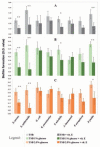Vitamin E for Prevention of Biofilm-caused Healthcare-associated Infections
- PMID: 31922015
- PMCID: PMC6944457
- DOI: 10.1515/med-2020-0004
Vitamin E for Prevention of Biofilm-caused Healthcare-associated Infections
Abstract
The healthcare-associated infections (HCAIs) occur in patients both in nosocomial environments and in community. More often HCAIs are associated to the use of medical devices and bacterial biofilm development on these equipments. Due to the clinical and economic relevance of this topic, new strategies for the treatment of infections caused by biofilm proliferation are unceasingly searched by scientists. The present study investigated the role of vitamin E to reduce the biofilm formation for a larger panel of human pathogens, including strains of Staphylococcus aureus, Staphylococcus epidermidis, Escherichia coli, Klebsiella pneumoniae, Proteus mirabilis, Acinetobacter baumannii, Pseudomonas aeruginosa and Pseudomonas putida. This potential activity was tested by placing a preparation of vitamin E (α-Tocopheryl acetate) as interface between the bacterial culture and the polystyrene walls of a 96 well plate at different concentrations of glucose, used as a biofilm enhancer. The Staphylococcus genus was further investigated by spreading the vitamin E on a silicone catheter lumen and evaluating its influence on the bacterial colonization. From our results, vitamin E has been able to interfere with bacterial biofilm and prevent in vitro biofilm formation. Furthermore, the ability of Staphylococcus aureus and Staphylococcus epidermidis to colonize the catheter surface decreased as a result of vitamin E application.
Keywords: Alpha-Tocopheryl acetate; Biofilm; Catheter; Medical devices; Vitamin E.
© 2020 Franca Vergalito et al., published by De Gruyter.
Conflict of interest statement
Conflict of interest: Authors state no conflicts of interest.
Figures


Similar articles
-
Effect of ovotransferrin, protamine sulfate and EDTA combination on biofilm formation by catheter-associated bacteria.J Appl Microbiol. 2007 Mar;102(3):722-7. doi: 10.1111/j.1365-2672.2006.03129.x. J Appl Microbiol. 2007. PMID: 17309621
-
Biofilm-forming capacity of Staphylococcus epidermidis, Staphylococcus aureus, and Pseudomonas aeruginosa from ocular infections.Invest Ophthalmol Vis Sci. 2012 Aug 17;53(9):5624-31. doi: 10.1167/iovs.11-9114. Invest Ophthalmol Vis Sci. 2012. PMID: 22736609
-
Cold-Azurin, a New Antibiofilm Protein Produced by the Antarctic Marine Bacterium Pseudomonas sp. TAE6080.Mar Drugs. 2024 Jan 25;22(2):61. doi: 10.3390/md22020061. Mar Drugs. 2024. PMID: 38393032 Free PMC article.
-
Evaluation of Antimicrobial Durability and Anti-Biofilm Effects in Urinary Catheters Against Enterococcus faecalis Clinical Isolates and Reference Strains.Balkan Med J. 2017 Dec 1;34(6):546-552. doi: 10.4274/balkanmedj.2016.1853. Balkan Med J. 2017. PMID: 29215338 Free PMC article.
-
Antibacterial Properties of Tebipenem Pivoxil Tablet, a New Oral Carbapenem Preparation against a Variety of Pathogenic Bacteria in Vitro and in Vivo.Molecules. 2016 Jan 6;21(1):62. doi: 10.3390/molecules21010062. Molecules. 2016. PMID: 26751436 Free PMC article.
Cited by
-
Biofilm destruction activity of α-tocopherol against Staphylococcus aureus, Proteus mirabilis, and Pseudomonas aeruginosa.FEMS Microbiol Lett. 2025 Jan 10;372:fnaf020. doi: 10.1093/femsle/fnaf020. FEMS Microbiol Lett. 2025. PMID: 39904546 Free PMC article.
-
Non-Antibiotic Compounds Synergistically Kill Chronic Wound-Associated Bacteria and Disrupt Their Biofilms.Pharmaceutics. 2023 May 31;15(6):1633. doi: 10.3390/pharmaceutics15061633. Pharmaceutics. 2023. PMID: 37376081 Free PMC article.
-
New Insight into Vitamins E and K1 as Anti-Quorum-Sensing Agents against Pseudomonas aeruginosa.Antimicrob Agents Chemother. 2021 May 18;65(6):e01342-20. doi: 10.1128/AAC.01342-20. Print 2021 May 18. Antimicrob Agents Chemother. 2021. PMID: 33820770 Free PMC article.
-
Current Knowledge on Biomaterials for Orthopedic Applications Modified to Reduce Bacterial Adhesive Ability.Antibiotics (Basel). 2022 Apr 15;11(4):529. doi: 10.3390/antibiotics11040529. Antibiotics (Basel). 2022. PMID: 35453280 Free PMC article. Review.
-
Vitamin D and vitamin K1 as novel inhibitors of biofilm in Gram-negative bacteria.BMC Microbiol. 2024 May 18;24(1):173. doi: 10.1186/s12866-024-03293-6. BMC Microbiol. 2024. PMID: 38762474 Free PMC article.
References
-
- Khan HA, Baig FK, Mehboob R. Nosocomial infections: Epidemiology, prevention, control and surveillance. Asian Pac J Trop Biomed. 2017;7(5):478–482. doi: 10.1016/j.apjtb.2017.01.019. Available from. - DOI
-
- Donlan R. Biofilms on Central Venous Catheters: Is Eradication Possible? Curr Top Microbiol Immunol. 2008;322:133–161. Feb 1; - PubMed
-
- Percival SL, Suleman L, Vuotto C, Donelli G. Healthcare-Associated infections, medical devices and biofilms: Risk, tolerance and control. J Med Microbiol. 2015;64(4):323–334. - PubMed
LinkOut - more resources
Full Text Sources
Molecular Biology Databases
